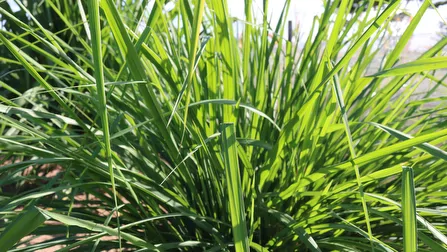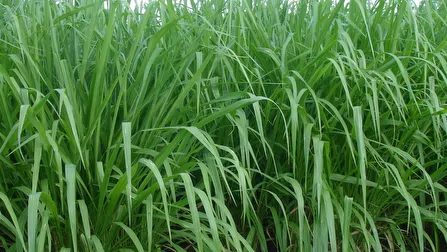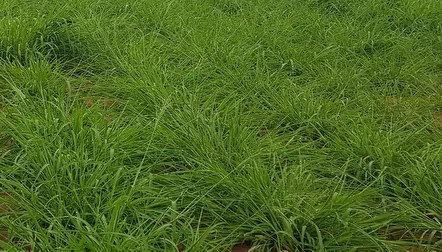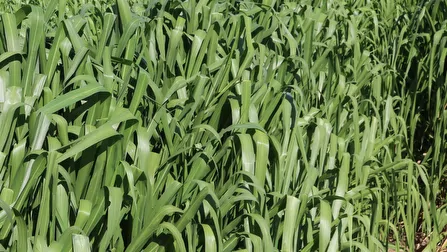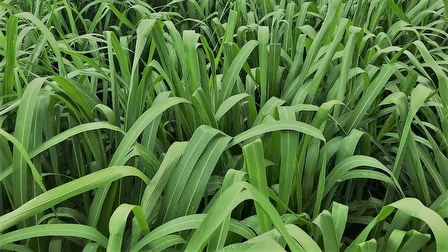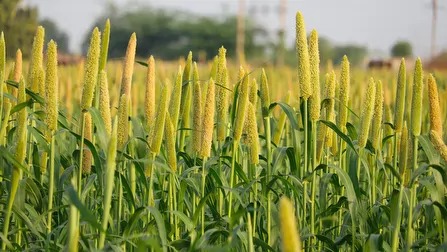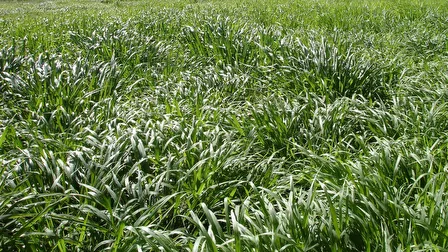
Indicação
Forrageira de excelente palatabilidade e qualidade nutricional, indicada para bovinos de cria, recria e engorda e produção leiteira. Pode também ser consumida por equinos e ovinos. É exigente em fósforo (P) e potássio (K), principalmente na fase de implantação. Recomenda-se o monitoramento da fertilidade através de análise, principalmente a aplicação de nitrogênio em cobertura para manutenção da produtividade forrageira.
Megathyrsus maximum cv. Tanzânia-I
Panicum maximum cv. Tanzânia-I
Alta fertilidade
Pastejo direto, feno e silagem
20 a 26 t/ha/ano de matéria seca (M.S.)
12 a 16%
Até 1,60m
Excelente
Excelente
Média
Alta
Perene
Origem
Foi introduzido no Brasil pela EMBRAPA. Coletado em 1969 em Korogwe– Tanzânia (África) pelo ORSTOM (Institut Français de Recherche Scientifique pour le Developpement em Coopération). Foi avaliado além do Brasil, no México, Cuba e Colômbia.
Características Agronômicas
É uma espécie forrageira exigente em fertilidade do solo, apresenta colmos mais finos que facilitam o seu manejo.
Utilização e Manejo
O Tanzânia-I é uma forrageira indicada para solos de alta fertilidade, corrigidos e adubados. É exigente em fósforo (P) e potássio (K), principalmente na fase de implantação. Recomendamos o monitoramento da fertilidade através de análise, principalmente a aplicação de nitrogênio em cobertura para manutenção da produtividade forrageira. É uma variedade de excelente palatabilidade e qualidade nutricional, podendo ser usada para todo o ciclo de produção de carne, leite, também para equinos, ovinos e caprinos. Em experimento de três anos de pastejo, ela foi superior aos cultivares Tobiatã e Colonião, tanto em ganho por animal quanto em ganho por área. O ganho diário por cabeça foi, em média, 720 g nas águas e 240 g na seca. Em área corrigida e adubada, tem mostrado boa aceitabilidade pelos bezerros, com ganhos de peso superiores aos obtidos na Brachiaria brizantha cv. Marandu. Os melhores resultados são obtidos em pastagens rotacionados, com 1 a 5 dias de pastejo e 25 a 30 dias de descanso, durante o período chuvoso e 45 a 50 dias no inverno. Em diversos experimentos a taxa de lotação ultrapassou a 4,0 U.A./ha. Pode ser utilizada por bovinos em fase de cria, recria e engorda, e produção de leite. Pode ser consumida por equinos, caprino e ovinos.
Características Morfológicas
É uma planta cespitosa de ciclo anual, com altura média de 1,3m, folha decumbente com largura média de 2,6cm. Lâminas e bainhas são glabras, sem cerosidade. Os colmos são levemente arroxeados. As inflorescências são do tipo panícula, com ramificações primárias longas, e secundárias longas apenas na base. As espiguetas são arroxeadas, glabras e uniformemente distribuídas. O verticilo é glabro.
